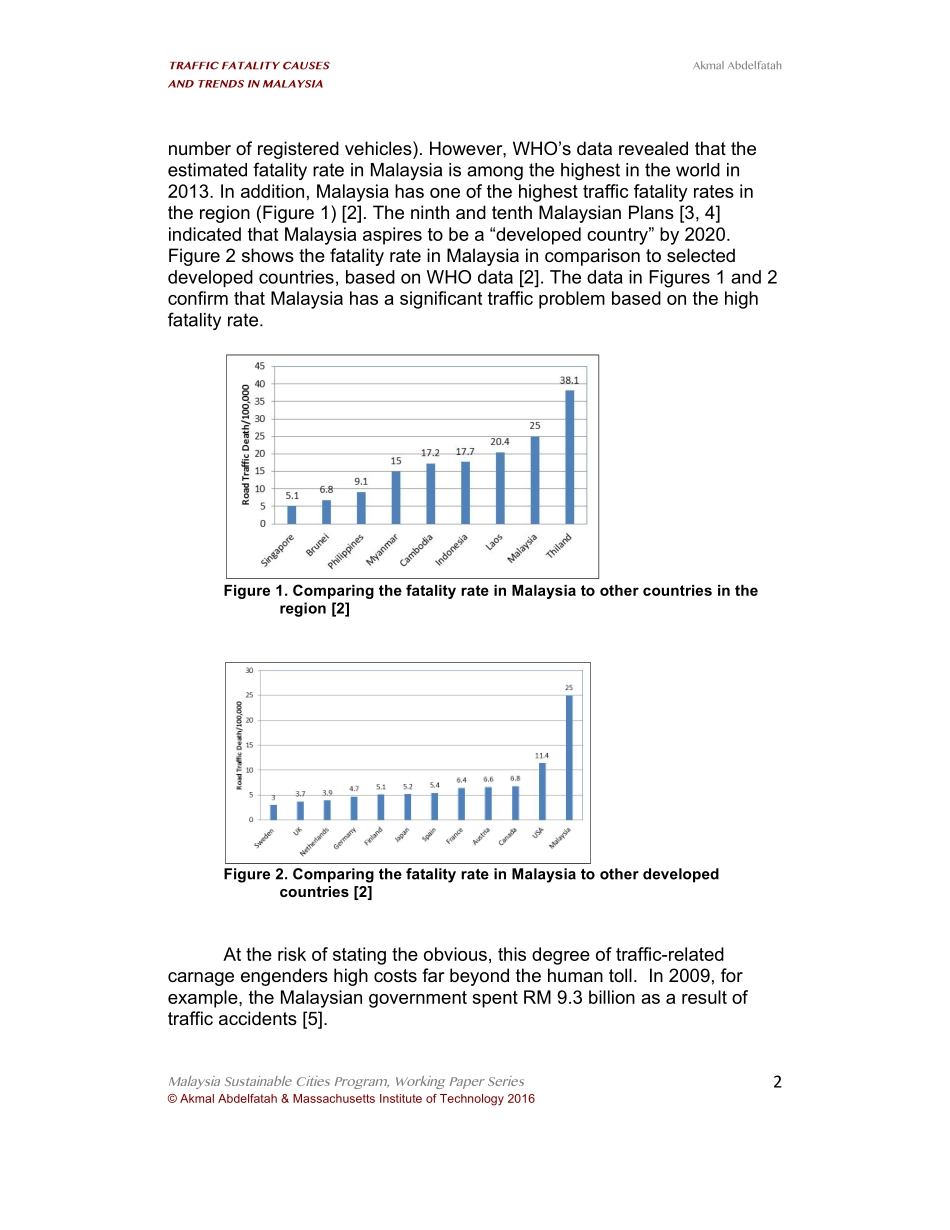TRAFFICFATALITYCAUSESANDTRENDSINMALAYSIAAkmalAbdelfatahMalaysiaSustainableCitiesProgram,WorkingPaperSeries©AkmalAbdelfatah&MassachusettsInstituteofTechnology20161TRAFFICFATALITYCAUSESANDTRENDSINMALAYSIAbyAkmalAbdelfatahCivilEngineeringDepartment,AmericanUniversityofSharjahAbstractRelativetoitspopulation,Malaysiahasoneofthehighesttrafficfatalityratesintheworld.ThispaperanalyzesMalyasiantrafficaccidentsandfatalityratetrendsinaneffortto(1)understandhowprivatevehicleusepatternsaffectfatalityrates,and(2)explorepolicychangesthatmightreducethenumberoftrafficfatalitiesinMalaysiancities.PrivatevehiclesinMalaysia—i.e.,passengercarsandmotorcycles—representmorethan90percentofallregisteredvehicles.Only1.3percentofaccidentsinvolvemotorcycles—andyet,motorcyclistscompriseastaggering60percentofalltrafficfatalities.Thetrendfortherateoffatalitiesper100,000Malaysiansshowsalmostaconstantvalueoverthestudyperiod.Thereisadecreasingtrend,however,whenconsideringthefatalityrateper100,000registeredvehicles.Atthesametime,thepercentageofmotorcyclefatalitiesincreasesoverthestudyperiod.Althoughtherearenospecificmonthswhentrafficfatalitiesaresignificantlyhigher,almost40percentoftrafficaccidentsoccurduringthelateafternoonandearlyevening.Thispapersuggestsshort-termandlong-termstrategiesthatmightreducemotorcyclefatalitiesinMalaysia,includingtheenforcementoftrafficregulations.IntroductionSustainabletransportationsystemsarevitalelementsofsustainablecities.Oneofthemajorfactorsthatinfluencestransportationsystemsustainabilityistrafficsafety.Trafficaccidentsrepresentamajorproblemfacingmanycountriesaroundtheworld.Infact,trafficaccidentshavebeenreportedastheninthmostcommoncauseofdeath,accordingtotheWorldHealthOrganization(WHO).Thetotalnumberofannualtrafficaccidentfatalitiesisestimatedtobeapproximately1.3million[1].Inalaterstudy,WHOestimatedthenumberoffatalitiestobeapproximately1.24million[2].Manycitiesaroundtheworldareworkingtoreducethetrafficfatalityrate(i.e.,thenumberoffatalitiesrelativetothepopulationortheTRAFFICFATALITYCAUSESANDTRENDSINMALAYSIAAkmalAbdelfatahMalaysiaSustainableCitiesProgram,WorkingPaperSeries©AkmalAbdelfatah&MassachusettsInstituteofTechnology20162numberofregisteredvehicles).However,WHO’sdatarevealedthattheestimatedfatalityrateinMalaysiaisamongthehighestintheworldin2013.Inaddition,Malaysiahasoneofthehighesttrafficfatalityratesintheregion(Figure1)[2].TheninthandtenthMalaysianPlans[3,4]indicatedthatMalaysiaaspirestobea“developedcountry”by2020.Figure2showsthefatalityrateinMalaysiaincomparisontoselecteddevelopedcountries,basedonWHOdata[2].ThedatainFigures1and2confirmthatMalaysiahasasignificanttrafficproblembasedonthehighfatalityrate.Figure1.ComparingthefatalityrateinMalaysiatoothercountriesintheregion[2]Figure2.ComparingthefatalityrateinMalaysiatootherdevelopedcountries[2]Attheriskofstatingtheobvious,thisdegreeoftraffic-relatedcarnageengendershighcostsfarbeyondthehumantoll.In2009,forexample,theMalaysiangovernmentspentRM9.3billionasaresultoftrafficaccidents[5].TRAFFICFATALITYCAUSESANDTRENDSINMALAYSIAAkmalAbdelfatahMalaysiaSustainableCitiesProgram,WorkingPaperSeries©AkmalAbdelfatah&MassachusettsInstituteofTechnology20163LiteraturereviewThefollowingliteraturereviewisdividedintotwomainsections.Thefirstprovidesasummaryofstudiesthathaveinvestigatedtheratesandcausesoftrafficaccidents/fatalitiesi...



 优质VIP
优质VIP 优质VIP
优质VIP 优质VIP
优质VIP 优质VIP
优质VIP 优质VIP
优质VIP 优质VIP
优质VIP 优质VIP
优质VIP 优质VIP
优质VIP 优质VIP
优质VIP 优质VIP
优质VIP